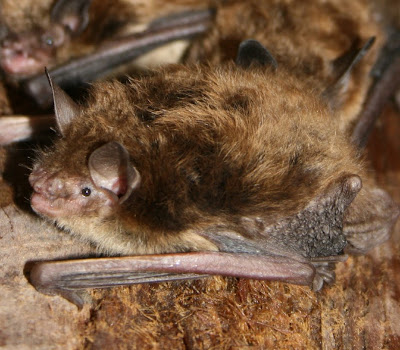
Little brown bat, Myotis lucifugus. Photo from batguys.com
Big brown bats are irreproachably cute micro foxes. And they're only big in comparison to pipistrelles and little brown bats. They're about 4 to 5 inches long, with a 11-13 inch wingspan. They weigh only 1/2 to 5/8 ounce. They don't have hollow bones or air sacs like birds; their flight is the feat of an acrobat who must flap continuously to stay aloft.
 The vast majority of bats found in homes are big brown bats. They seem to be better (or worse, depending on how thrilled you are at finding one in your kitchen) at getting into the occupied parts of houses.
The vast majority of bats found in homes are big brown bats. They seem to be better (or worse, depending on how thrilled you are at finding one in your kitchen) at getting into the occupied parts of houses.Care of overwintering bats is not difficult, because they sleep all day and almost around the clock. I can change the papers, food and water in her tank without ever disturbing her as she hangs on the sidewall, hidden in her toweling. She eats live mealworms, which are fed my new favorite nutritious substance, chick starter, with carrots for moisture. This is called "gut loading." The idea is, if you feed the worms good stuff, the bat or whatever eats them gets good stuff, too. I can attest that mealworms grow like Topsy when kept in chick starter. It would seem to me to be a good idea for anyone feeding mealworms to wild birds to keep them in chick starter rather than plain old fashioned oats. But then I'm all about taking care of wild things, and I'm thinking a lot more about nutrition these days, having had some evidence that we can hurt the things we love most with the wrong foods.
When the towels get soiled, every four days or so, I gently fold her into her dirty washcloth and place her in a lidded Tupperware. Then I thoroughly clean the tank and gently transfer her to freshly-laundered towels on the tank wall. That's my favorite part, because I get to talk to her and transfer her from one towel to another. At first I had to unhook her feet from the dirty towel, but now she scuttles up onto the clean towel as soon as I open my hand. Bats learn fast.
Routine care doesn't make her mad any more. I get just a little whiff of musk from her facial glands, a pleasantly skunky waft, a desultory chitter. And her fur is smooth and shiny, not all rumbly like it was when I first got her. She's been preening. I can see the towels shake as she rearranges her fur. Sometimes I see her licking her hooks and feet and armbones like a cat. She can scratch her head and neck with her hind feet. Having always thought of bats as kind of bound up in their own wing and tail membranes, I'm pleased and surprised to see how flexible and mobile they are.
I risk a stroke toward her back end as I hold her head and wings securely in the glove. It's amazing. Her fur is so soft you can't even feel it. She doesn't so much as turn her head, but she kind of shrinks in when I touch her. Her whole being vibrates, and I imagine she is talking, saying something about my temerity for daring such a thing.

She hangs there all day, sleeping and preening and scratching, folded into her towels. She much prefers dark colored cloths. She's become so tame that it's hard to get her to chitter and cuss at me now. I wish I had taken photos of her teeth when she was just captured--they are impressive! Edges like a pinking shears, oversized for her tiny mouth, and strong--she would bite the tweezers and nearly twist them from my fingers, clang!! No wonder I was a little eepy about her.
Here's the not-so-easy part of keeping a bat over the winter. It needs to be released when the weather warms reliably in spring, when the nights stay in the 50's. And several weeks before that, it needs to have a heated place where it can exercise and get its muscles conditioned for flight. And there's the rub. I have a tent made of nylon screening that would be a fabulous flight space, except for the fact that any big brown bat worth its salt would be outta there in two minutes. They're escape artists par excellence. At the Ohio Wildlife Center, they have to roll up towels under the flight room door, for goodness' sake, because the bats will go out that tiny space. Smart, smart, smart. And tiny, tiny, tiny, and endlessly flattenable, like flying Flat Stanleys, bats are. So I'll have to head to Columbus for flight conditioning several weeks before release time. And pray that Dee Dee doesn't have her bab(ies) before she's released near her maternity roost.
All right. I've made some of this bat care thing sound easy. But I have to tell you that you MUST have a permit from your state to keep any wild animal, and for a rabies vector species like a bat, you must also have a RVS certification on that permit. This is for your own protection as well as the bat's. They're not pets. They do a good job of looking like them on my blog. But I don't cuddle them and I handle them as little as possible. They're wild animals and they're destined for release.
The day my permit came in the mail with the rabies vector certification on it, I decided that I wouldn't trade it for a diamond ring. What can you learn from a diamond ring?
No comments:
Post a Comment